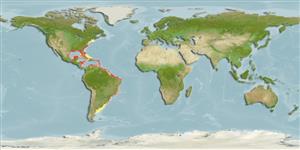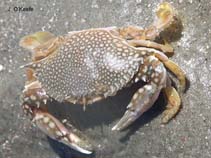Arenaeus cribrarius (Lamarck, 1818)
Speckled swimming crab| Native range | All suitable habitat | Point map | Year 2050 |

|
| This map was computer-generated and has not yet been reviewed. |
| Arenaeus cribrarius AquaMaps Data sources: GBIF OBIS |
Classification / Names Common names | Synonyms | CoL | ITIS | WoRMS
Malacostraca | Decapoda | Portunidae
Environment: milieu / climate zone / depth range / distribution range Ecology
Benthopelagic; dH range: 27.5 - 35; depth range 0 - 68 m (Ref. 97531). Tropical
Distribution Countries | FAO areas | Ecosystems | Occurrences | Introductions
Western Atlantic: USA to Argentina.
Length at first maturity / Size / Weight / Age
Maturity: Lm ? range ? - ? cm Max length : 14.1 cm CW male/unsexed; (Ref. 367)
Short description Morphology
Carapace more than twice as broad as long; 9 teeth on broadly arched anterolateral margin (outer orbital tooth and strong lateral spine included); front not so advanced as outer orbital teeth, bearing, between the inner orbital angles, one pair of bicuspid teeth (resulting from the coalition of 2 separate pairs). Convex dorsal surface finely granulate, fissures on orbital margin broadly open; lower surface of carapace hairy; pincers moderate-sized; legs rather short and broad, densely fringed with hairs; fifth legs flattened in form of paddles. Basal segment of abdomen produced on each side into a strong, sharp, slightly upcurved spine. Color: dorsal surface, including pincers, light reddish brown to olive brown covered with many small, rounded white spots, tips of walking legs yellow; color pattern persisting in alcohol.
Minimum carapace width: 2.28 cm (Ref. 93549).
Life cycle and mating behavior Maturity | Reproduction | Spawning | Eggs | Fecundity | Larvae
Ovigerous females have been reported from May to September.
Main reference
References | Coordinator | Collaborators
Tavares, M. 2003. (Ref. 367)
IUCN Red List Status (Ref. 130435: Version 2024-1)
CITES status (Ref. 108899)
Not Evaluated
CMS (Ref. 116361)
Not Evaluated
Threat to humans
Human uses
Fisheries: minor commercial
| FishSource |
Tools
More information
Trophic Ecology
Ecology
Population dynamics
Life cycle
Distribution
Human Related
Aquaculture profile
Stamps, Coins Misc.
Stamps, Coins Misc.
Outreach
References
Internet sources
BHL | BOLD Systems | CISTI | DiscoverLife | FAO(Publication : search) | Fishipedia | GenBank (genome, nucleotide) | GloBI | Gomexsi | Google Books | Google Scholar | Google | PubMed | Tree of Life | Wikipedia (Go, Search) | Zoological Record
Estimates based on models
Preferred temperature
(Ref. 115969): 22.5 - 28, mean 25.6 (based on 452 cells).
Price category
(Ref. 80766):
Unknown.



